skip to main |
skip to sidebar
Yep, I've jumped onto the "rice salad" bandwagon, despite my doubts about what a salad actually is. :) Or perhaps I should call this a no-cook "raw" pulao. A salad by any other name - probably tastes exactly the same... right? I actually wasn't entirely certain if this would be to my taste, but as it turned out, it's delicious - IF you like raw onions. I do, and I think the salad tasted even better for sitting overnight in the fridge, when I had it the next day for lunch. At room temperature, I should add. I don't like to eat anything that's refrigerator-cold... not even sandwiches. It has to be room temperature, at the very least.
PS. I saw this recipe on someone's blog, but for the life of me I can't remember whose it was. If you recognise this recipe, dear blogger, please give me a heads-up and I will add a link to your original recipe together with an acknowledgement.
Recipe for: Curried brown rice salad
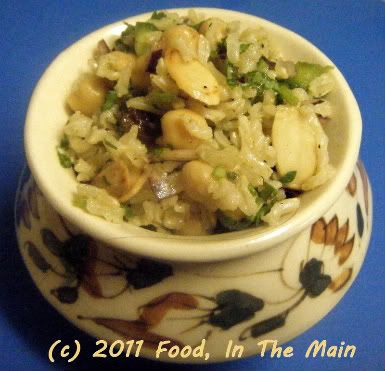 Ingredients:
Ingredients:
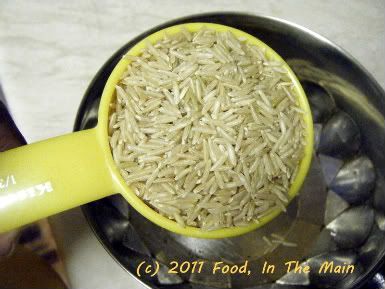 1/3 cup brown basmati rice
1/3 cup brown basmati rice
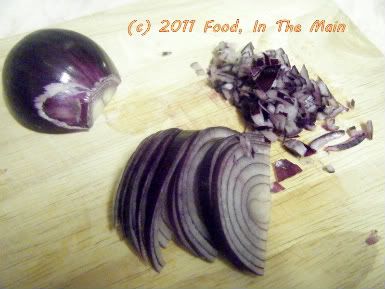 2 tbsp red onion, minced
2 tbsp green bell pepper, minced
1/3 cup chickpeas, cooked (fresh or canned)
3 tbsp coriander, chopped fine
1 tsp sultanas/raisins
2 tbsp red onion, minced
2 tbsp green bell pepper, minced
1/3 cup chickpeas, cooked (fresh or canned)
3 tbsp coriander, chopped fine
1 tsp sultanas/raisins
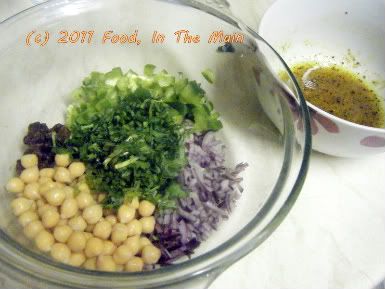 1 tsp sliced almonds, toasted, for garnish
For the dressing:
1 tbsp lime juice
1 tsp orange blossom honey
2 tsp extra virgin olive oil
1 tsp commercial curry powder (I used Schwartz medium-hot)
Salt and pepper to taste
Method:
1. Soak the brown rice for a few hours if possible; put the soaked rice in a pan with a well fitting lid and add 2/3 cup water. Bring to a boil, then turn the heat down to a gentle simmer, cover the pan and let the rice cook till all the water has been absorbed (about 15 minutes). Let the cooked rice sit undisturbed for 15 minutes.
1 tsp sliced almonds, toasted, for garnish
For the dressing:
1 tbsp lime juice
1 tsp orange blossom honey
2 tsp extra virgin olive oil
1 tsp commercial curry powder (I used Schwartz medium-hot)
Salt and pepper to taste
Method:
1. Soak the brown rice for a few hours if possible; put the soaked rice in a pan with a well fitting lid and add 2/3 cup water. Bring to a boil, then turn the heat down to a gentle simmer, cover the pan and let the rice cook till all the water has been absorbed (about 15 minutes). Let the cooked rice sit undisturbed for 15 minutes.
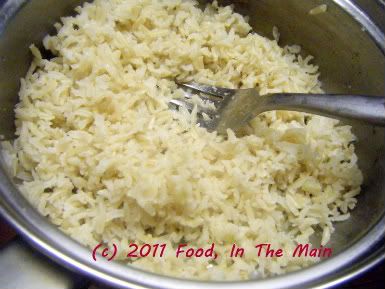 Once it has cooled, fluff gently with a fork. Reserve.
2. In a medium bowl, mix the salad ingredients bar the toasted almonds.
Once it has cooled, fluff gently with a fork. Reserve.
2. In a medium bowl, mix the salad ingredients bar the toasted almonds.
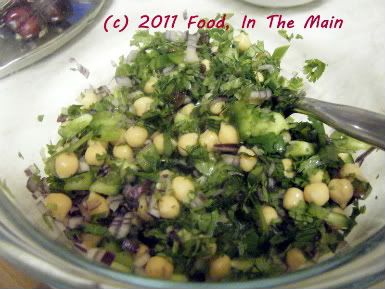 Then add the rice and mix gently to combine.
3. In a small bowl, whisk the ingredients for the dressing.
Then add the rice and mix gently to combine.
3. In a small bowl, whisk the ingredients for the dressing.
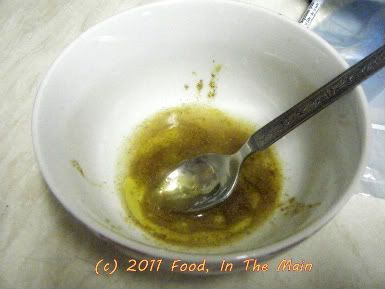 Pour the dressing over the salad and mix again, adding salt and pepper. Taste and adjust the dressing ingredients.
Pour the dressing over the salad and mix again, adding salt and pepper. Taste and adjust the dressing ingredients.
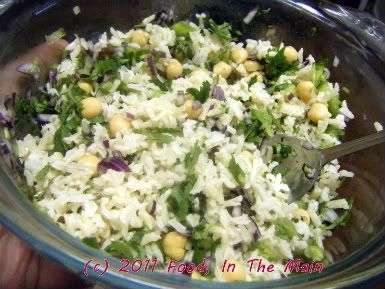 Fluff with a fork so as not to make the rice mushy.
Fluff with a fork so as not to make the rice mushy.
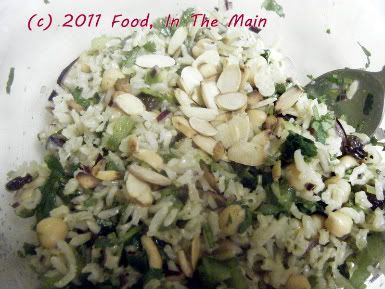 Sprinkle the toasted almonds over. Serve at room temperature, or chilled.
RECIPE: CURRIED BROWN RICE SALAD
Ingredients:
1/3 cup brown rice
2 tbsp red onion, minced
2 tbsp green bell pepper, minced
1/3 cup chickpeas
3 tbsp coriander, chopped fine
1 tsp sultana/raisins
1 tsp sliced almonds, toasted
For the dressing:
1 tbsp lime juice
1 tsp orange blossom honey
1 tsp extra virgin olive oil
1 tsp commercial curry powder (I used Schwartz medium-hot)
Salt and pepper to taste
Method:
1. Soak the brown rice for a few hours if possible; put the soaked rice in a pan with a well fitting lid and add 2/3 cup water. Bring to a boil, then turn the heat down to a gentle simmer, cover the pan and let the rice cook till all the water has been absorbed (about 15 minutes). Let the cooked rice sit undisturbed for 15 minutes. Once it has cooled, fluff gently with a fork. Reserve.
2. In a medium bowl, mix the salad ingredients bar the toasted almonds. Then add the rice and mix gently to combine.
3. In a small bowl, whisk the ingredients for the dressing. Pour the dressing over the salad and mix again, adding salt and pepper. Taste and adjust the dressing ingredients. Fluff with a fork so as not to make the rice mushy. Serve at room temperature.
Sprinkle the toasted almonds over. Serve at room temperature, or chilled.
RECIPE: CURRIED BROWN RICE SALAD
Ingredients:
1/3 cup brown rice
2 tbsp red onion, minced
2 tbsp green bell pepper, minced
1/3 cup chickpeas
3 tbsp coriander, chopped fine
1 tsp sultana/raisins
1 tsp sliced almonds, toasted
For the dressing:
1 tbsp lime juice
1 tsp orange blossom honey
1 tsp extra virgin olive oil
1 tsp commercial curry powder (I used Schwartz medium-hot)
Salt and pepper to taste
Method:
1. Soak the brown rice for a few hours if possible; put the soaked rice in a pan with a well fitting lid and add 2/3 cup water. Bring to a boil, then turn the heat down to a gentle simmer, cover the pan and let the rice cook till all the water has been absorbed (about 15 minutes). Let the cooked rice sit undisturbed for 15 minutes. Once it has cooled, fluff gently with a fork. Reserve.
2. In a medium bowl, mix the salad ingredients bar the toasted almonds. Then add the rice and mix gently to combine.
3. In a small bowl, whisk the ingredients for the dressing. Pour the dressing over the salad and mix again, adding salt and pepper. Taste and adjust the dressing ingredients. Fluff with a fork so as not to make the rice mushy. Serve at room temperature.
I think this is the second recipe on my blog that involves aubergines. In five years plus of blogging, only the second recipe. There is a very good reason for this – I hate aubergines. Pete likes them, though, and occasionally guilt overcomes loathing and I make something specially for him, with the purple horrors as the star ingredient. (The guilt has to build up slowly over the years, as there is an awful lot of loathing to overcome.)
Anyway, this is very definitely an aubergine lover’s dream dish. It’s supposed to be served as a side with grilled lamb chops, but if you’re vegetarian, feel free to dive right in. It’s a pretty dry dish – it might even do well as part of a tapas spread, come to think of it. The onion base tastes absolutely delicious with the garlic and balsamic vinegar and pine nuts, and I am going to make the dish again, at some point, with bell peppers - although I’d probably leave out the raisins. Should do very nicely over spiced couscous, methinks...
Recipe for: Mediterranean-style aubergine
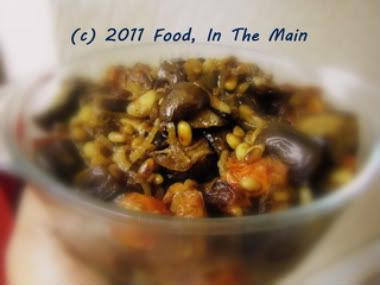
Ingredients:
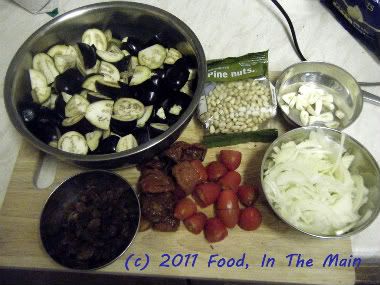
4 cups baby aubergines, quartered
4 cloves garlic, thickly sliced
2 small onions, sliced very fine
2 tbsp extra virgin olive oil
8-10 baby plum tomatoes, cut in half
3 tbsp sundried tomatoes
1 tsp cumin seeds
1/2 tsp cinnamon powder
2 tbsp pine nuts
2 tbsp raisins
2 tsp caster sugar
1 tbsp balsamic vinegar
2 tbsp red wine vinegar
Salt to taste
Method:
1. Heat 1 tbsp extra-virgin olive oil in a large pan and add the garlic and onion.
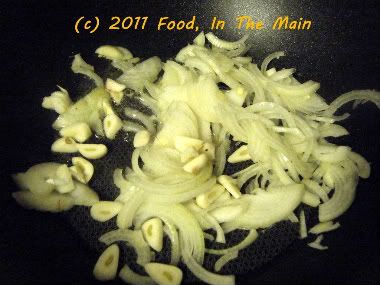
2. Cook for about 5 minutes over a medium heat, until soft and just starting to brown. Remove from the pan and reserve.
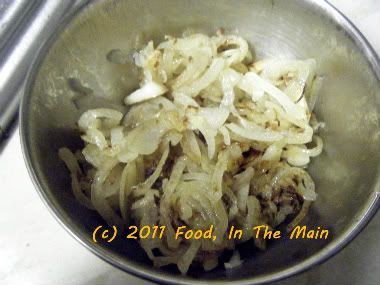
3. Turn up the heat a bit, add the remaining olive oil to the pan. Add the cumin seeds.
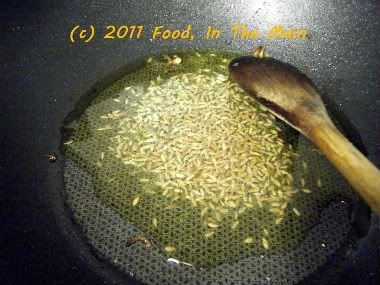
4. Now add the aubergine and fry it, stirring often, for 7-8 minutes, until the aubergine is soft and starting to brown.
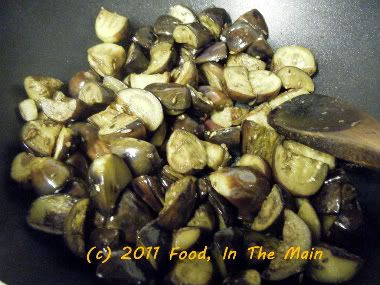
5. Sprinkle in the raisins and pine nuts and stir it all together.
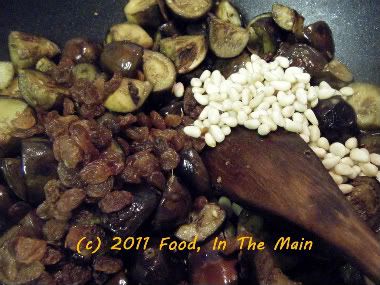
6. Throw in the reserved onion and garlic,

plus the halved plum tomatoes and the ovendried/sundried tomatoes.
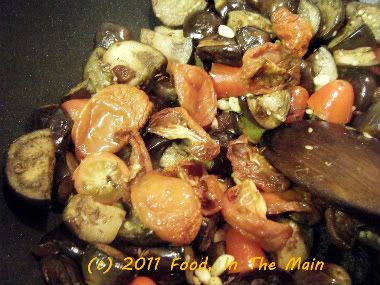
7. Cook for 3-4 minutes, stirring occasionally, until the tomatoes begin to soften.
8. Sprinkle 2 tsp caster sugar and 1 tbsp balsamic vinegar, 2 tbsp white wine vinegar over the aubergine. Stir together until well combined. Add salt to taste, check for seasoning, then remove from the heat.
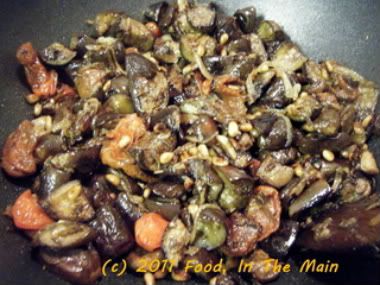
9. Serve warm with couscous, or at room temperature as a snack.
Garnish with a few mint leaves sliced into strips.
RECIPE: MEDITERRANEAN-STYLE AUBERGINE
Ingredients:
4 cups baby aubergines, quartered
4 cloves garlic, thickly sliced
2 small onions, sliced very fine
2 tbsp extra virgin olive oil
8-10 baby plum tomatoes, cut in half
3 tbsp sundried tomatoes
1 tsp cumin seeds
1/2 tsp cinnamon powder
2 tbsp pine nuts
2 tbsp raisins
2 tsp caster sugar
1 tbsp balsamic vinegar
2 tbsp red wine vinegar
Salt to taste
Method:
1. Heat 1 tbsp extra-virgin olive oil in a large pan and add the garlic and onion.
2. Cook for about 5 minutes over a medium heat, until soft and just starting to brown. Remove from the pan and reserve.
3. Turn up the heat a bit, add the remaining olive oil to the pan. Add the cumin seeds.
4. Now add the aubergine and fry it, stirring often, for 7-8 minutes, until the aubergine is soft and starting to brown.
5. Sprinkle in the raisins and pine nuts and stir it all together.
6. Throw in the reserved onion and garlic, plus the halved plum tomatoes and the ovendried/sundried tomatoes.
7. Cook for 3-4 minutes, stirring occasionally, until the tomatoes begin to soften.
8. Sprinkle 2 tsp caster sugar and 1 tbsp balsamic vinegar, 2 tbsp white wine vinegar over the aubergine. Stir together until well combined. Add salt to taste, check for seasoning, then remove from the heat.
9. Serve warm, stirred into couscous, or at room temperature as a salad. Garnish with a few mint leaves sliced into strips.
I unearthed this cake recipe from a binder of printed-off recipes from long ago (over 7 years) which I rediscovered last week. The recipe was from the New Yorker.
I know why I’d printed it off (because, intriguingly, olive oil is one of the ingredients in the cake) and I also know why I didn’t end up making it right away – because blood oranges are also among the ingredients. I didn’t have a clue what blood oranges were, at that point, and didn’t know where I could source them either.
I didn’t think about substituting regular oranges (duh) – because I didn’t have much experience baking, and I didn’t know if the recipe would work without the blood oranges that were called for.
Lastly, but not leastly (Why can’t it be said that way? Well, I have now, and it’s here to stay. More fun than “last but not least”, isn’t it?) I literally had no idea what “supreming an orange” was. I mean, I could safely assume that “blood orange” was a variety of orange. But “supreme of orange” could have been, for all I knew, really bad English to mean that blood oranges were supreme among oranges. Well, how was I to know any different?
It’s only fairly recently that I learnt what it is to “supreme an orange” – basically, a flashy, “cheffy” way of using a paring knife to peel an orange, cut out the segments and remove the seeds and as much of the white pith as possible, retaining only the juicy inner bits.
Phooey. We’ve been doing it in India forever, mainly to feed the orange to toddlers. Of course ours is a hands-on technique, literally – and yeah, the end result isn’t as pretty as when an orange is “supremed” with a knife. But it is also an unfussy way of doing a simple job. Ah well... I guess Western chefs didn’t invent the technique with the intention of feeding toddlers; their orange supremes are usually to garnish fancy desserts.
Each technique obviously has its plus points. But for the purposes of THIS recipe, fancy supreming was really not required, as the slices would neither be retained whole, nor used as a garnish. And had I known this 7 years ago, I might have tried the cake 7 years ago.
However, that’s neither here nor there (just don’t ask me where, please). This is my first olive oil cake, and I admit I was wondering if the oil would taste nice in a sweet citrus-flavoured cake. I was very relieved not to be able to taste it at all, when I sampled the cake later. The cake is not very sweet, because I misread the instructions and ended up with a very liquidy batter necessitating the addition of more flour... but I didn't add any extra sugar.
The recipe below shows the adjusted quantities. However, it still takes a LONG time to bake – I had to leave mine shortly after I’d put the batter in the oven, to drop off my stepson and his girlfriend at their respective homes. What with having to drive to two destinations 12 miles apart (more or less) through a HORRIBLY thick fog late at night on narrow country roads, it took me a good hour and a half to return.
My husband, deep in work mode, had not even realised there was a cake slowly charring in the oven, so by the time I dashed in to the rescue, the cake was PRETTY brown and rather crisper on top than I would have liked. However, much to my surprise, it was not crisp and overdone all the way through – in fact, it was perfectly done on the inside. So obviously it had needed the long cooking period. If I’d been in the house, I would probably have sheltered the cake with aluminium foil after an hour or so, to prevent it from over-browning.
So, as I was saying, the cake may not be very sweet even with the adjusted sugar quantity. I like it that way but if you have a sweeter tooth, I’d suggest you make a simple icing with orange juice and icing sugar and pour it (or spread it – whichever your preference) over the top of the cake after it has cooled.
Recipe for: Citrus olive oil cake
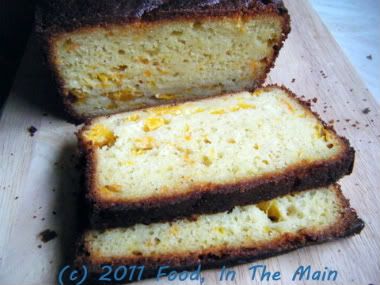 Ingredients:
3 medium oranges
1 small lemon
1-1/4 cup sugar
Buttermilk or plain yogurt
3 large eggs
2 cups all-purpose flour
1 1/2 teaspoons baking powder
1/2 teaspoon baking soda
1/4 teaspoon salt
2 tsp vanilla extract
2/3 cup extra virgin olive oil
Method:
1. Preheat oven to 350 degrees. Grease a 9-by-5-inch loaf pan really well. Grate zest from 2 oranges and the lemon, and place in a bowl with sugar. Using your fingers, rub ingredients together until the zest is evenly distributed in the sugar.
Ingredients:
3 medium oranges
1 small lemon
1-1/4 cup sugar
Buttermilk or plain yogurt
3 large eggs
2 cups all-purpose flour
1 1/2 teaspoons baking powder
1/2 teaspoon baking soda
1/4 teaspoon salt
2 tsp vanilla extract
2/3 cup extra virgin olive oil
Method:
1. Preheat oven to 350 degrees. Grease a 9-by-5-inch loaf pan really well. Grate zest from 2 oranges and the lemon, and place in a bowl with sugar. Using your fingers, rub ingredients together until the zest is evenly distributed in the sugar.
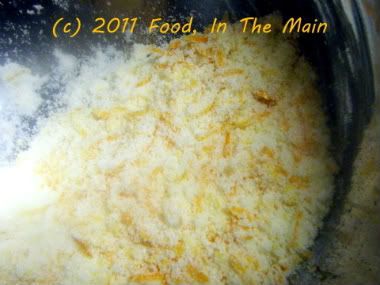 2. Cut the zested oranges in half and remove the segments. Remove as much of the white pith as possible, retaining the inner pulp. Do this over a bowl so that you don't waste the juice or any pulp. Keep the pulp in small chunks as much as possible, rather than disintegrate it.
2. Cut the zested oranges in half and remove the segments. Remove as much of the white pith as possible, retaining the inner pulp. Do this over a bowl so that you don't waste the juice or any pulp. Keep the pulp in small chunks as much as possible, rather than disintegrate it.
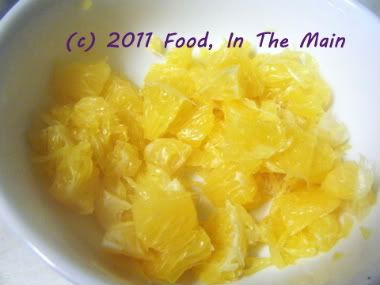 3. Cut the remaining orange in half and squeeze the juice into a measuring cup. Do the same with the zested lemon.
4. Add enough buttermilk or yogurt to the juice to make 2/3 cup liquid.
3. Cut the remaining orange in half and squeeze the juice into a measuring cup. Do the same with the zested lemon.
4. Add enough buttermilk or yogurt to the juice to make 2/3 cup liquid.
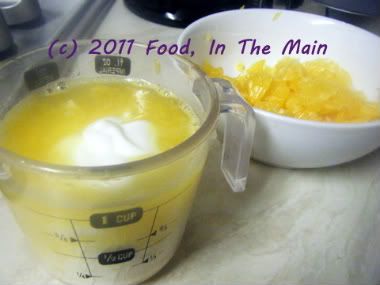 5. Pour the mixture into the bowl with sugar and whisk well,
5. Pour the mixture into the bowl with sugar and whisk well,
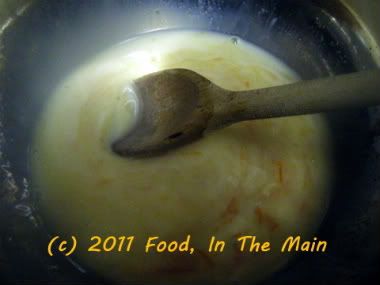 then whisk in the eggs one by one.
then whisk in the eggs one by one.
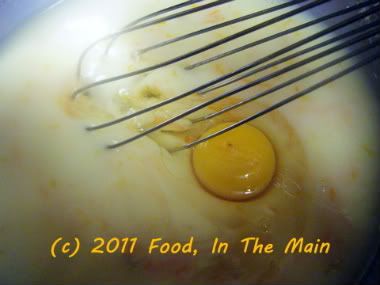 6. In another bowl, whisk together flour, baking powder, baking soda and salt. Gently whisk dry ingredients into the wet ones.
6. In another bowl, whisk together flour, baking powder, baking soda and salt. Gently whisk dry ingredients into the wet ones.
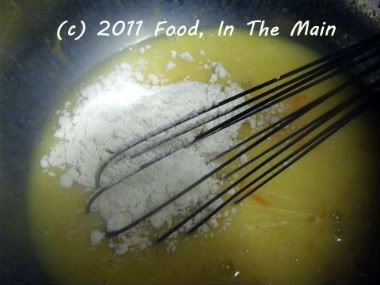 7. Now, using a spatula, fold in the oil a little at a time.
7. Now, using a spatula, fold in the oil a little at a time.
 8. Fold in the pieces of orange segments.
8. Fold in the pieces of orange segments.
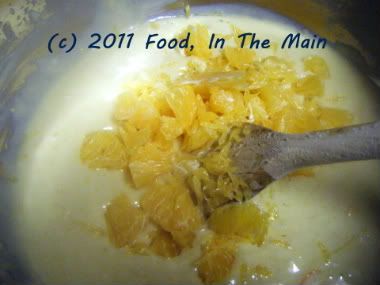 Pour the batter into the prepared pan and smooth the top.
Pour the batter into the prepared pan and smooth the top.
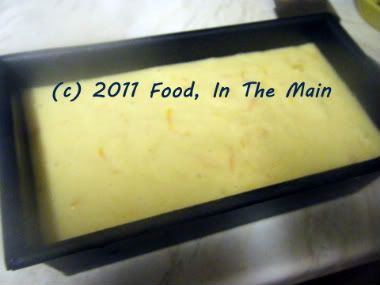 9. Bake the cake for at least 55 minutes (cover the top with foil if it looks like browning too quickly), or until it is golden and a tester inserted in the cake comes out clean.
9. Bake the cake for at least 55 minutes (cover the top with foil if it looks like browning too quickly), or until it is golden and a tester inserted in the cake comes out clean.
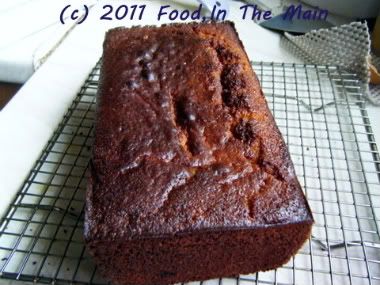 Cool on a rack for 5 minutes, then unmould carefully and cool to room temperature right-side up.
You can make a simple icing for the top, if you have a strong sweet tooth.
(Caveat: Ovens differ in temperature, so don't put your trust totally in the baking time given. Check the cake after about 45 minutes and keep checking every so often till it is cooked.)
RECIPE: CITRUS OLIVE OIL CAKE
Ingredients:
3 medium oranges
1 small lemon
1-1/4 cups sugar
Buttermilk or plain yogurt
3 large eggs
2 cups all-purpose flour
1 1/2 teaspoons baking powder
1/2 teaspoon baking soda
1/4 teaspoon salt
2/3 cup extra virgin olive oil
Method:
1.Preheat oven to 350 degrees. Grease a 9-by-5-inch loaf pan really well. Grate zest from 2 oranges and the lemon, and place in a bowl with sugar. Using your fingers, rub ingredients together until the zest is evenly distributed in the sugar.
2. Cut the zested oranges in half and remove the segments. Remove as much of the white pith as possible, retaining the inner pulp. Do this over a bowl so that you don't waste the juice or any pulp. Keep the pulp in small chunks as much as possible, rather than disintegrate it.
3. Cut the remaining orange in half and squeeze the juice into a measuring cup.
4. Add enough buttermilk or yogurt to the juice to make 2/3 cup liquid.
5. Pour the mixture into the bowl with sugar and whisk well, then whisk in the eggs one by one.
6. In another bowl, whisk together flour, baking powder, baking soda and salt. Gently whisk dry ingredients into the wet ones.
7. Now, using a spatula, fold in the oil a little at a time.
8. Fold in the pieces of orange segments. Scrape the batter into the prepared pan and smooth the top.
9. Bake the cake for at least 55 minutes (cover the top with foil if it looks like browning too quickly), or until it is golden and a tester inserted in the cake comes out clean. Cool on a rack for 5 minutes, then unmould and cool to room temperature right-side up. You can make a simple icing for the top, if you have a strong sweet tooth.
Cool on a rack for 5 minutes, then unmould carefully and cool to room temperature right-side up.
You can make a simple icing for the top, if you have a strong sweet tooth.
(Caveat: Ovens differ in temperature, so don't put your trust totally in the baking time given. Check the cake after about 45 minutes and keep checking every so often till it is cooked.)
RECIPE: CITRUS OLIVE OIL CAKE
Ingredients:
3 medium oranges
1 small lemon
1-1/4 cups sugar
Buttermilk or plain yogurt
3 large eggs
2 cups all-purpose flour
1 1/2 teaspoons baking powder
1/2 teaspoon baking soda
1/4 teaspoon salt
2/3 cup extra virgin olive oil
Method:
1.Preheat oven to 350 degrees. Grease a 9-by-5-inch loaf pan really well. Grate zest from 2 oranges and the lemon, and place in a bowl with sugar. Using your fingers, rub ingredients together until the zest is evenly distributed in the sugar.
2. Cut the zested oranges in half and remove the segments. Remove as much of the white pith as possible, retaining the inner pulp. Do this over a bowl so that you don't waste the juice or any pulp. Keep the pulp in small chunks as much as possible, rather than disintegrate it.
3. Cut the remaining orange in half and squeeze the juice into a measuring cup.
4. Add enough buttermilk or yogurt to the juice to make 2/3 cup liquid.
5. Pour the mixture into the bowl with sugar and whisk well, then whisk in the eggs one by one.
6. In another bowl, whisk together flour, baking powder, baking soda and salt. Gently whisk dry ingredients into the wet ones.
7. Now, using a spatula, fold in the oil a little at a time.
8. Fold in the pieces of orange segments. Scrape the batter into the prepared pan and smooth the top.
9. Bake the cake for at least 55 minutes (cover the top with foil if it looks like browning too quickly), or until it is golden and a tester inserted in the cake comes out clean. Cool on a rack for 5 minutes, then unmould and cool to room temperature right-side up. You can make a simple icing for the top, if you have a strong sweet tooth.
When I was new to pasta and found out that there were all sorts of different shapes available, I used to imagine that they would all taste different as well, perhaps because of being made from different things (in keeping with the varied shapes). I didn’t realise then that the pasta shapes were made with different styles of sauces in mind – thick and meaty sauces would need large shapes that would hold the sauce, pasta salads would only require small shapes with no "holding" characteristics and so on.
So when a more world-cuisine-savvy friend of mine pointed out that all pasta, no matter the shape or size, were made from durum wheat (with minor variations like the addition of egg or spinach), I was terribly disappointed.
“You mean they all have different names and look different but are made from the same ingredients?" I asked disbelievingly."Yes," he said, uncompromisingly. "Are you quite sure? They're all made from the same ingredients?” I asked for the second time in as many minutes, unwilling to let go of my illusion that each had its own taste.
“Yes, quite sure,” he said again, unable to figure out why I sounded so let-down.
I persisted with my questioning even in the face of his blunt reply. “Then they all taste the same? Just the sauces are different? All the cooked pasta have the same bland taste?"
“YES,” he said, again uncompromisingly but this time with an added edge of irritation.
“But then what’s the POINT?” I wailed.
“What do you mean, what’s the point?” Full-on exasperation, there.
“What’s the POINT of having different shapes if it’s all just the same damn thing? What’s the big deal about pasta then? It’s really the sauce that matters, not the pasta itself.”
And that was when I got the lecture about diff’rent strokes for diff’rent folks, to use a phrase not coined by me in a context probably totally unlike the original coining.
Although I eventually learnt to accept that all pasta may just be pasta but none of them are JUST pasta, still in my heart of hearts there lingers the faint echo of my original outburst... “But what’s the big deal about pasta, then?”
On the other hand, I’ve had people say to me, on being informed that South Indian cuisine is based predominantly around rice with different “sauces” (sambar, rasam, kootu, etc) to flavour it: “But rice is just like pasta then, isn’t it?”
It has been only with the greatest reluctance that I could bring myself to admit that yes, in that ONE way rice IS like pasta... but it’s also so very much MORE than pasta! Different varieties of rice, when cooked, taste and smell different and have different textures. I’m guessing that it’s only of late that scientists have been “inventing” new varieties of rice – but even that is only reinvention (using Nature’s bounty) at best, or tampering (with Nature’s bounty) at worst.
Pasta, on the other hand, completely an artificial invention (seen any pasta fields lately, folks?), has no distinguishing natural characteristics by way of shape or size (beyond those created by humans) or taste (beyond the “taste” of the sauce in which it is dunked).
So, bottomline - no, pasta is most definitely not like rice.
However, over the years, I’ve quite learnt to like pasta and I do understand about the shapes and sizes and uses.
Here’s a recipe with one of each – size, shape and use.
Recipe for: Pasta with rocket (arugula) pesto
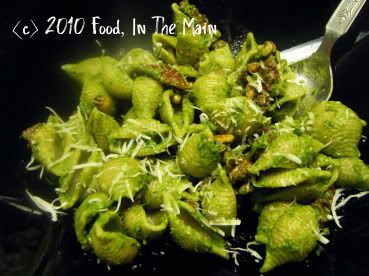
Ingredients:
Whole-wheat pasta - orecchiette or conchigliette for choice, but penne or farfalle will do
4 cups rocket (arugula), washed and patted dry
1/4 cup fresh basil leaves
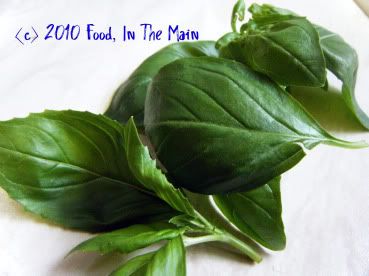
3-4 cloves of garlic
1 tbsp fresh lemon juice
3/4 cup pine nuts (can substitute walnuts)
About 1/4 cup good quality extra virgin olive oil
1/3 cup sundried tomatoes in oil, well drained
Salt and pepper to taste
Grated or shaved Parmigiano reggiano for garnish
Method:
1. Toast the pine nuts in a skillet till golden brown, taking care not to burn them. Set aside to cool.
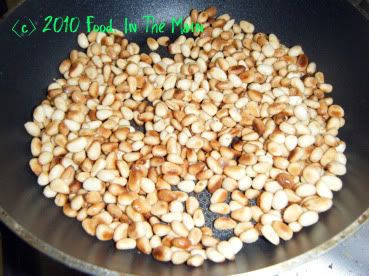
2. In a food processor or mixie, add half the toasted pine nuts (reserving the other half), garlic, rocket (arugula) leaves and basil. Squeeze or pour the lemon juice over the leaves.
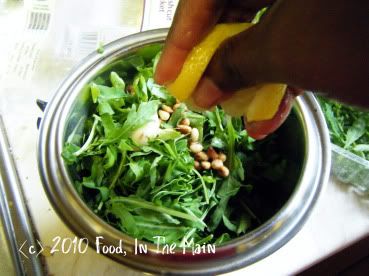
3. Now add olive oil little by little, as required, to help grind the leaves and nuts smoothly.
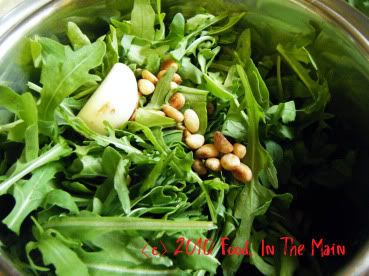
You might not need to use all the olive oil, just use as much as required.
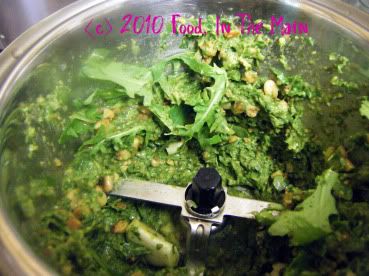
4. When the ingredients have been ground up into a fairly smooth pesto, remove the pesto to a bowl.

5. Add plenty of pepper and salt to taste.
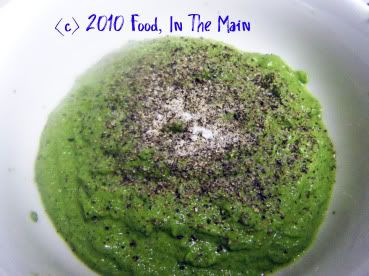
6. Cook the pasta till al dente in plenty of salted water, and drain off the water when the pasta is done. Return the pasta to the pan.
7. Slice the drained sundried tomatoes thinly.

8. Add 3-4 tbsp of the pesto to the pasta and mix in thoroughly. Taste for seasoning and add more pesto if required, making sure that every bit of the pasta is covered.
Add the sliced sundried tomatoes and stir them in,
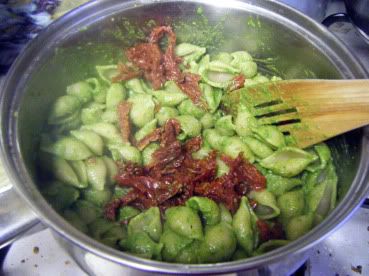
then add the reserved toasted pine nuts. Toss or stir the pasta to distribute the pine nuts evenly.
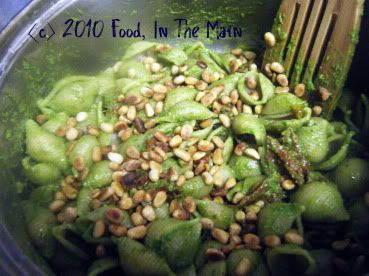
9. Serve the pasta in warmed bowls with generous shavings or gratings of parmigiano reggiano as garnish.











































